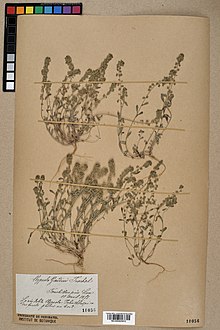Real tortoiseshell
| Real tortoiseshell | ||||||||||||
|---|---|---|---|---|---|---|---|---|---|---|---|---|

Real tortoiseshell ( Clypeola jonthlaspi ) |
||||||||||||
| Systematics | ||||||||||||
|
||||||||||||
| Scientific name | ||||||||||||
| Clypeola jonthlaspi | ||||||||||||
| L. |
The True Schildkraut ( Clypeola jonthlaspi ) is a plant from the genus of sign herbs ( Clypeola ) in the family of the cabbage family (Brassicaceae).
description
Vegetative characteristics
The real tortoiseshell is an annual herbaceous plant that reaches heights of 5 to 10, rarely up to 30 centimeters. The upright or ascending stem is often branched at the bottom. The above-ground parts of the plant are covered with pressed star hairs and simple hairs gray-white and only occasionally red.
The sitting, small and simple leaves are basal and distributed on the stem. The simple, hairy leaf blade has entire margins and is oblanceolate to spatulate. The basal leaves are up to 1.5–2 inches long and the stem leaves are smaller.
Generative characteristics
The flowering period extends from March to May. The racemose inflorescence contains many flowers, it extends considerably when the fruit is ripe.
The very small, hermaphrodite flowers have a diameter of about 1.5 millimeters. The 1.5 millimeter long petals are initially yellow and finally whitish.
The relatively short fruit stalk with a length of 2 to 3 millimeters is bent down. The small, more or less hairy to bald and lonely, non-opening pods are flat with a winged, fringed edge and almost rounded with a diameter of 3 to 5 millimeters.
The number of chromosomes in both subspecies is 2n = 32.
Occurrence
The real tortoiseshell occurs in the Mediterranean area from North Africa north to Switzerland , Ukraine and east to Pakistan in western Asia . It thrives on rock corridors and on dunes.
The real tortoiseshell occurs in Switzerland only in the central Rhone valley . It thrives there on dry, sandy soils , especially under rocky outcrops in the collinous-montane elevation . In Switzerland, Clypeola jonthlaspi grows according to Delarze et al. 2015 as a character species in plant communities of the Association of Heat-loving Limestone Pioneers = Alysso Sedion.
Systematics
The first publication was in 1753 Clypeola jonthlaspi by Carl von Linné in Species Plantarum , page 652. Synonyms for Clypeola jonthlaspi L. are: Alyssum jonthlaspi (L.) Clairv. , Clypeola ambigua Jord. & Fourr. , Clypeola glabra Boiss. , Clypeola monosperma Lam.
Some authors have about two subspecies:
- Clypeola jonthlaspi L. subsp. jonthlaspi
- Clypeola jonthlaspi subsp. microcarpa (Moris) Fiori (Syn .: Clypeola microcarpa Moris ): It occurs on Mallorca , Ibiza , in Spain , North Macedonia and Bulgaria .
Individual evidence
- ↑ a b c d e f g h i j Clypeola jonthlaspi In: Info Flora , the national data and information center for Swiss flora . Accessed July 30, 2020.
- ↑ a b c d e Peter Schönfelder , Ingrid Schönfelder: The new cosmos Mediterranean flora. Franckh-Kosmos-Verlag Stuttgart 2008, ISBN 978-3-440-10742-3 , p. 148.
- ^ Johann Christoph Röhling : Germany's flora. Fourth volume, Wilmans, 1833, pp. 591 f.
- ↑ Clypeola jonthlaspi at Tropicos.org. In: IPCN Chromosome Reports . Missouri Botanical Garden, St. Louis
- ↑ a b c Karol Marhold, 2011: Brassicaceae. : Datasheet Clypeola jonthlapi In: Euro + Med Plantbase - the information resource for Euro-Mediterranean plant diversity.
Web links
- Clypeola jonthlaspi at Bulgarian Flora.
- Clypéole on florealpes.com.

